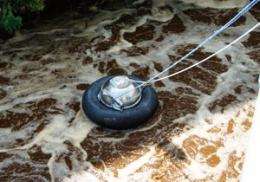Survey Shows Poorly Designed Wastewater Treatment Plants May Emit More Nitrous Oxide

(PhysOrg.com) -- The first large-scale survey of 12 wastewater plants across the U.S., led by Columbia scientists, shows that the magnitude of N2O emissions from these wastewater treatment plants may be more variable and complex than previously thought. It also challenges the current Intergovernmental Panel on Climate Change (IPCC) approach for assessing N2O emissions from such plants. The findings of the study, which was funded by the Water Environment Research Foundation, appeared May 13 on the website of Environmental Science & Technology.
Nitrous oxide, or N2O, is a greenhouse gas considered by experts to be 300 times more powerful in its atmospheric warming effect than carbon dioxide. While the greatest recorded sources of N2O are from agricultural activities and fossil fuel combustion, sewage breakdown by some wastewater treatment plants also contribute to emissions. Until this survey was conducted, nitrous oxide emissions from plants using microbes to breakdown toxins—called biological nitrogen removal (BNR)—was estimated to be rather low.
The study’s principal investigator, Kartik Chandran, assistant professor at the Fu Foundation School of Engineering and Applied Science, explains that nitrous oxide emissions to date have only been estimated because there has not been a consistent way to measure N2O from plants using biological nitrogen removal. To solve this problem, the Columbia team devised the first protocol to measure these emissions from full-scale water purification facilities, which has been reviewed by the U.S. Environmental Protection Agency (EPA) and adopted by plants across the nation and in some countries in Europe. Using this protocol, emissions of N2O can be measured in real-time during different phases of treatment within a single plant. To conduct this study, the Columbia team took measurements of N2O from around the nation, 24 hours a day for several weeks over a two-year period, to gain an understanding of spatial and temporal variability in N2O emissions.
Chandran studies the role of microorganisms in both natural and engineered systems. His research has shown that bacteria involved in breaking down human waste are to blame for the emission of both nitrous oxide and nitric oxide (NO), which causes atmospheric smog. Human waste contains proteins that are eventually converted to ammonia-nitrogen. When left untreated, ammonia flows into surrounding water bodies and can lead to marine life sickness and death. To prevent nitrogen-related impairment of water quality, biological wastewater treatment plants transform the ammonia and organic nitrogen compounds into nitrogen gas, which makes up about 79 percent of the earth’s atmosphere and is benign. The two-phase process of biological nitrogen removal in wastewater treatment plants involves bacteria that oxidize ammonia to create nitrate (called the aerobic phase) while different bacteria reduce nitrate, turning it into benign nitrogen gas, which is then released to the atmosphere (the anoxic phase).
A more accurate inventory of nitrogen emissions from wastewater treatment plants can affect policies regarding nitrous oxide and nitric oxide emissions. Prior to Chandran’s study, it was not known how much N2O is emitted from plants using a BNR process, although preliminary calculations implicated BNR as a potentially dominant source. The EPA currently estimates that approximately 88 plants in the U.S. utilize this process.
As a result of the survey using the new protocol, the team found that aerobic zones—the phase in which bacteria treats the ammonia, turning it into nitrate—generally contribute more to nitrous oxide emissions. This is important because the IPCC approximation method assumes that N2O is only emitted from anoxic zones—when nitrate is turned into nitrogen. "Based on our actual measurements, aerobic zones contribute far more N2O than anoxic zones. This is one reason why current emissions estimates are potentially inaccurate, since they completely ignore aerobic zone emissions," said Chandran.
The EPA has estimated that wastewater treatment plants contribute just 1.6 percent to the total global emissions of N2O; however, the researchers found that measured emission factors from some BNR processes varied directly as a function of wastewater treatment process efficiency and were highly variable. High ammonia and nitrite concentrations, especially in the presence of high amounts of dissolved oxygen, were implicated as triggers.
The team hopes their findings will lead to a reconsideration of the design and operation of both new and old BNR reactors, modifying them to convert the ammonium and nitrite to nitrogen gas rather than N2O. As water quality mandates become more stringent, numerous wastewater treatment plants will be required to shift from non-BNR to BNR, to remove nitrogen.
“Until our study, everyone was following the IPCC estimation method to approximate emissions,” he said. “Based on our study, we have found that wastewater treatment plants, that are not performing optimally, are mainly responsible for N2O emissions.” Knowing the triggers for increased N2O emissions, Chandran says, will make it possible to design and operate BNR plants that not only meet water quality regulations, but also minimize N2O.
Provided by Columbia University

















